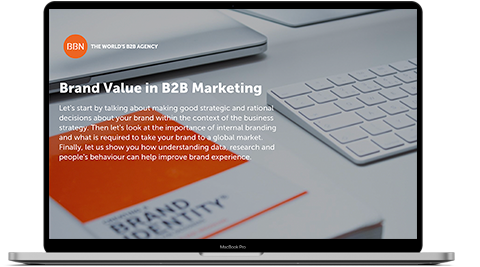Posted by BBN Central on 23rd Apr 2024
Quality Over Quantity: A Strategic Content Investment
Welcome to the fourth instalment in our series of seven articles, each dedicated to exploring smart investment strategies for fearless
READ MOREPosted by BBN Central on 11th Jul 2023
A surprising number of industrial B2Bers still hang their hats on an English-language, one-size-fits-all website as their hub for global marketing. But let’s face it: you’re not global unless you meet a minimum localisation threshold with your online presence. Our B2B experts have some ideas on what that means.
“The minimum website experience is translated content. Period. You can’t risk the appearance of irrelevance or worse, arrogance by sending global visitors to an English-only website,” said Arroyave, an accomplished multi-lingual global marketer with plenty of international experience. She added, “And if your products are designed or offered specifically by region, your website must reflect that. Customers must see what is applicable to them and their environment.”
Sejr Madsen agrees. “We must market globally, and we recognise language adaptations are the basic point of entry. We have one website translated into the ten key languages essential to our business. We also ensure downloadable documents are offered in a country-specific manner.”
However, the ‘minimum’ extends beyond simply swapping out English copy for another language. Basheer clarified: “Don’t forget about website performance. Your websites must load quickly and deliver an optimal experience wherever they are accessed.”
For example, the number of letters in a given word varies from language to language. For instance, a word in Portuguese may have twice as many letters as the same word in English. Consequently, pixel widths and design complications can arise. Many content management systems (CMS) and web developers fail to consider this. Headlines run into extra lines or become misaligned; images are shifted into odd places; unintended page breaks occur. These can express bias and favouritism to your English-speaking visitors, even if unintentionally.
Respect each of your pages as you would each of your customers. You need to translate your templates and designs in addition to translating your copy. This extra attention paid to detail will go a long way.
Once your minimum threshold for a localised web presence is met, you can consider more sophisticated experiences for global audiences.
Jorgenson employs a more decentralised approach. He noted that Danfoss offers websites with a full range of country-specific content for geographic markets with significant business opportunities. Other variations include versions of their website for smaller-opportunity geos where the content is less extensive and customised but still translated. They deploy even more customised versions in certain geos where a particular customer type is prominent.
Sidders describes the ideal global website experience: “Beyond ensuring customers see the right products for their region, we should also strive toward a more personal experience. That means letting the visitor choose their region and then serving up the language, imagery and support information specific to their area.”
See Also: The Marketing Globetrotter: Creative that can go the distance
The search engine marketing (SEM) environment takes time to master just in one country, let alone on a global scale. But that hasn’t deterred globally ambitious brands from forging ahead to attract and convert website visitors.
Madsen said that for Brüel & Kjær, HBK, search engine optimisation (SEO) is important in global marketing efforts. “Keywords are defined early as part of every campaign planning process. The fact that we do this on a global basis adds a level of complexity, but we are intent on finding the balance between great content that is also localised and search optimised.”
Jorgenson noted Danfoss is similarly committed to SEO globally. “We have a great focus on SEO but must balance corporate and local needs to get the best performance. We also know SEO isn’t enough. We balance these organic efforts with our paid programs while ensuring we have the right tools to capture the opportunities we create.”
Make sure to let Google know where your translated pages are and how they relate to their English counterparts by adding an ‘hreflang’ tag to your HTML or sitemaps. This tells Google that a group of pages are effectively the same but presented in different languages. Not only does this help to avoid technical issues like duplicative content penalisation, but it also allows Google to point users to the best pages possible on your site, depending on the language and theme of the user’s query.
Like the ‘hreflang’ tag, LinkedIn offers a convenient affiliate page system in which multiple LinkedIn company pages, each with a specific regional or linguistic focus, can be connected to a primary brand identity. Often, companies try to juggle posts in multiple languages on the same account or face conflict between regions posting similar messages at competing times of the day. Not only does this confuse audiences, but it doesn’t segment them well. Affiliate pages offer a simple way to address this by allowing regional autonomy without losing track of the brand’s bigger-picture goals. Just make sure your different regional marketing teams are clear about how to represent your brand and adhere to some common posting cadences, messaging practices, etc.
Creating multi-language, customised websites is daunting for many B2B marketers; our experts agree there are no excuses for having anything less than language-friendly websites for global visitors. So are there any helpful tips to making this easier (and affordable) to implement and maintain for your business? We asked an agency expert to weigh in.
“You don’t have to do it all at once,” noted Andrew Humphrey, director of media strategy at TriComB2B. “If you’re not on an urgent timeline, try testing a paid digital promotion for a specific service or product in a new international region, but only serve your ads to English speakers. If a topic resonates, you can take the next step and translate your pages, assets and ad copy supporting that product or service in the region’s primary language preferences. Keep escalating your efforts as you learn what’s working and what isn’t. This is a fail-safe approach for many businesses just trying to dip their toes into international outreach for the first time.”
About the AuthorThis article was originally co-produced by U.S.-based BBN partner TriComB2B and Cross-Border Communications in a white paper published by TriComB2B titled ‘Top Considerations for Highly Effective B2B Global Marketing.’ TriComB2B is unabashedly devoted to industrial and technical B2B marketing, helping clients design optimised marketing strategies that drive decisions in complex, considered purchases. |
Posted by BBN Central on 11th Jul 2023
We've gathered thoughts and expertise from our top strategists to bring you this insightful publication in B2B marketing. Get our e-Book to understand how you can build brand value in your organisation.

1 email a month, EXCLUSIVE stories, and 10 minutes of your time.
Subscribe now
Posted by BBN Central on 23rd Apr 2024
Welcome to the fourth instalment in our series of seven articles, each dedicated to exploring smart investment strategies for fearless
READ MORE
Posted by BBN Central on 12th Apr 2024
Welcome to the third instalment, focusing on smart investment strategies for fearless marketers aiming to win market share in the
READ MORE
Posted by BBN Central on 5th Apr 2024
In B2B marketing, the compass that points businesses towards success is increasingly data-driven. Here at BBN, we've been keenly observing
READ MORE
Posted by BBN Central on 29th Mar 2024
Since the introduction of Sora, OpenAI's text-to-video model, the worlds of AI and marketing have been abuzz. It's being called
READ MORE